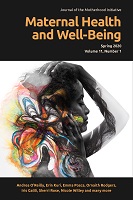Maternal Mental Health and Mindfulness
Abstract
Mental health problems result in disease and disability (Afifi 385). When looking at the data across cultures, women are more likely to report mental health symptoms, access available supports, and receive treatment for mental health disorders (Lesesne and Kennedy 755). Research on maternal health has suggested that “the burden of mental health disorders peak in the child bearing and midlife periods” (Lesesne and Kennedy 756). Biology is often implicated in this presumed psychological vulnerability, given that throughout a woman’s life, she experiences pronounced hormone-driven cycles, including menstruation, pregnancy, a postpartum period, and menopause. However, even after exhaustive studies exploring a number of sex-related variables, there is a lack of consensus regarding the significance hormones have in influencing women’s mental health challenges (Hendrick et al. 93; Schiller et al. 49). Some scholars contend that the focus on biology and hormones are an easy way to discount the negative experiences that disproportionately affect girls and women. Discrimination, poverty, sexism, abuse, exploitation, and caregiving burdens work to undermine women’s mental health. Women’s mental health should, therefore, be understood by evaluating all aspects of women’s lived experiences—physical, sociocultural, economic, and interpersonal. Informed by the diathesis-stress model, this article reconsiders the social, political, and economic stress that adversely affects women’s wellbeing. Specifically, this article posits that Buddhist-derived interventions, such as mindfulness, can fortify and empower women. Evidence from neurobiology provides a meaningful framework supporting this approach to health and wellness.Downloads
Published
How to Cite
Issue
Section
License
All intellectual property in relation to material included on this site belongs to the Motherhood Initiative for Research and Community Involvement (MIRCI). All material on this site is protected by Canadian and international copyright and other intellectual property laws. Users may not do anything which interferes with or breaches those laws or the intellectual property rights in the material. All materials on the Motherhood Initiative for Research and Community Involvement (MIRCI) are copyrighted and all rights are reserved. Any reproduction, modification, publication, transmission, transfer, sale, distribution, display or exploitation of the information, in any form or by any means, or its storage in a retrieval system, whether in whole or in part, without the express written permission of the Motherhood Initiative for Research and Community Involvement (MIRCI) is prohibited. Please contact us for permission to reproduce any of our materials. This site may include third party content which is subject to that third party's terms and conditions of use.


